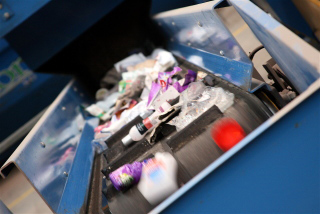Inferior recyclate from MRFs costs UK £51m a year
A new report released yesterday (19 December) has found that the presence of ‘poor and inconsistent quality recyclate’ from material recovery facilities (MRFs), represents a significant financial burden to UK reprocessors and manufacturers.
The ‘Costs of Contamination Report 2012’, saw the Resource Association (RA) survey its nine reprocessor members about costs relating to operational contamination levels at their MRFs. It found that the average operation contamination rate was 5.85 per cent and cost the UK over £51 million a year.
The ‘conservative’ estimate represents an average cost of £15.67 per tonne for over 3 million tonnes of reprocessing capacity featured in the survey. This equates to ‘around half of the UK’s reprocessing capacity for paper, card, plastics, aluminium and glass’.
The report comes amidst a mounting debate over the quality of recyclate collected from co-mingled collections and according to the RA, serves to ‘inform the debate about high quality recycling and how to achieve it’.

The report reads: ‘In the climate in which claims are made about the efficiencies and reduced costs associated with co-mingled and MRF sorting systems in the UK, we thought it time to understand better how costs that were perhaps incurred in collection systems appear to have shifted and become cost burdens for our manufacturing base’.
The RA states that government now needs to take a ‘fresh look at the whole municipal recycling supply chain’, including action to better regulate the output of MRFs through a ‘mandatory MRF Code of Practice’. This would, the RA argues, ‘demonstrably improve the quality of UK MRF output through a robust system of monitoring, material sampling and unannounced inspections’.
RA chairman, Andy Doran, said: “This report clearly shows the extent to which poor and inconsistent quality of recyclate adds real cost for the UK manufacturing base.
“This represents a missed opportunity for the UK – it is a cost burden that hampers investment and costs jobs, all to the detriment of the UK green economy.”
The report also suggests that if government rechannelled the costs of contamination from just one year into infrastructure (rather than them being absorbed by the reprocessing sector), it could ‘create up to 700 direct and supply chain jobs’ and ‘significantly support the government’s ambitious plastics packaging recycling targets.’
RA Chief Executive, Ray Georgeson, said: “The drive for quantity has come in part at the expense of quality, and what might be seen as the delivery of cost savings at the collection end of recycling appears simply to be shifting costs in the manufacturing end of recycling.
“We question how long must the UK reprocessing sector carry this burden.”
Matthew Farrow, Director of Policy at trade association, Environmental Services Association added: "The levels of non-target material in recyclate can depend on householder behaviour, collection method, and, where the material passes through a MRF, the sorting equipment and management systems in the MRF. The aim should be a transparent market where reprocessors know exactly what they are buying and a price is set which reflects the quality of the material and the investments made at both collection/sorting and reprocessing parts of the supply chain.
"Making the ESA Code of Practice for MRFs mandatory will help deliver this and we are pleased that the Resource Association agrees with the ESA on this. We hope that the Defra consultation on recyclate quality due out in January will propose a mandatory Code of Practice."
Other actions the RA recommends in tackling the ‘unsustainable burden on UK reprocessors’, include: further ‘robust action by regulators to enforce TFS [transfrontier shipment] Regulations and ensure that all recyclate exported meets legal quality requirements’; and seeing ‘government and its agencies’ conduct more research to ‘understand better the relationship between collection systems, public behaviour and contamination of recyclate’.
It is hoped that this could improve communications and operational practice to ‘deliver better quality’.
Read the ‘Costs of Contamination Report 2012’





